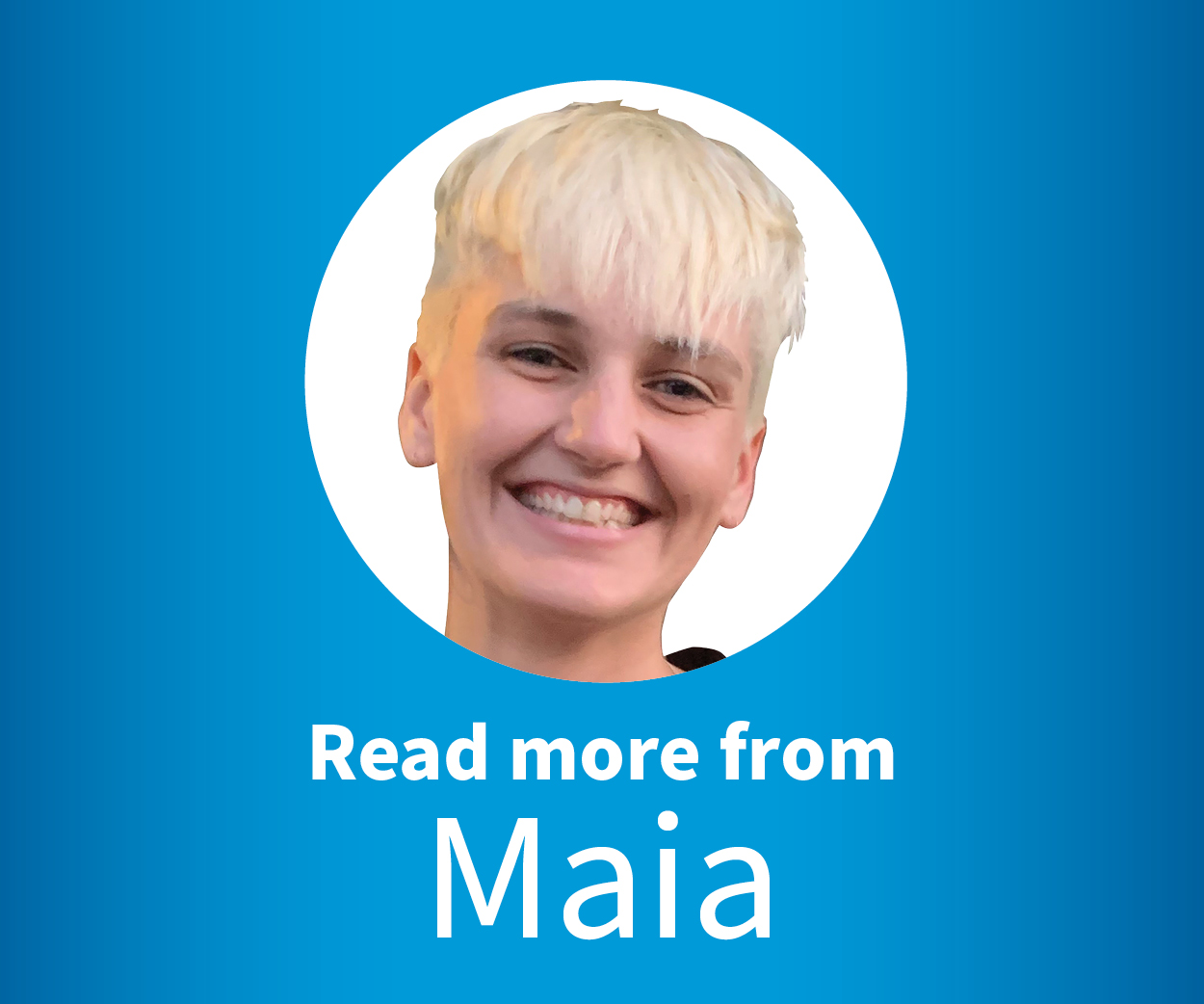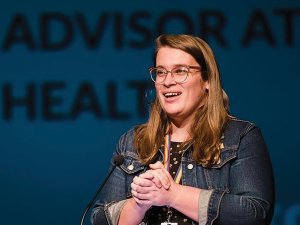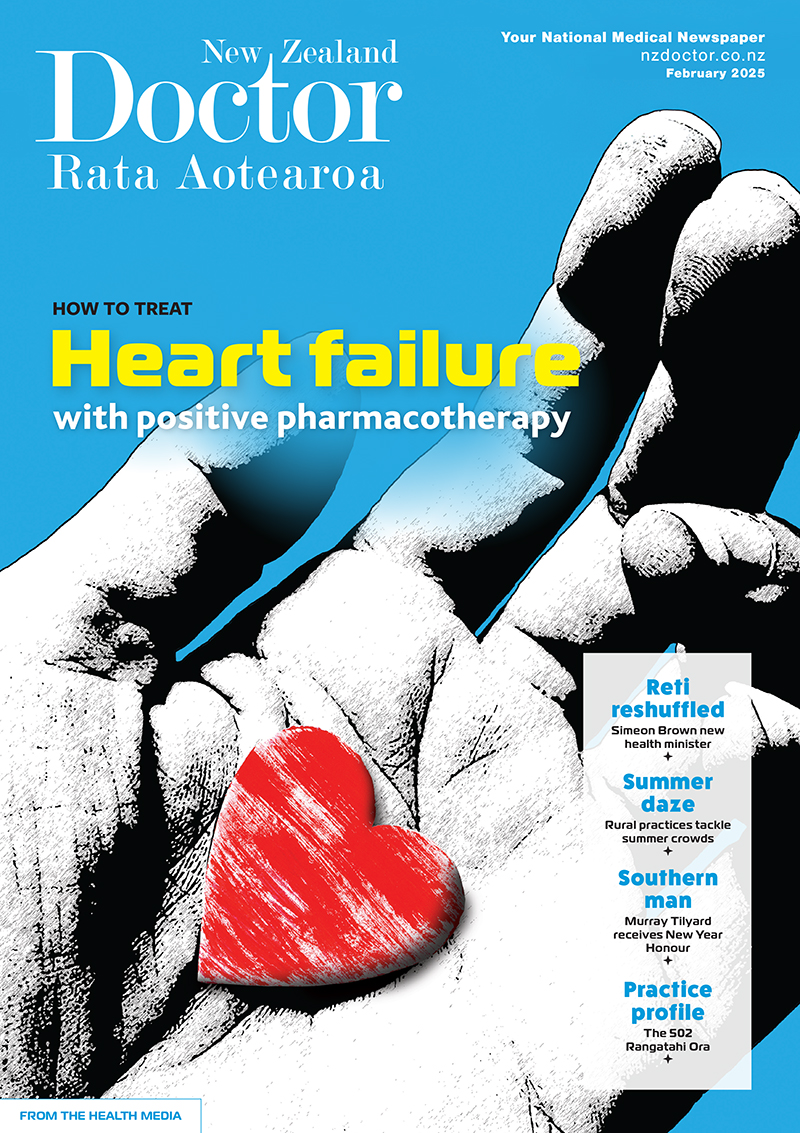Pharmacist prescribers Linda Bryant and Leanne Te Karu discuss positive polypharmacy for heart failure. Current evidence shows the intensive implementation of four medications offers the greatest benefit to most patients with heart failure, with significant reductions in cardiovascular mortality, heart failure hospitalisations and all-cause mortality
‘How do we not know about this?’: In search of informed and equitable healthcare for LGBTQIA+ patients
‘How do we not know about this?’: In search of informed and equitable healthcare for LGBTQIA+ patients

Maia Hall talks with practitioners leading the way towards providing high-quality healthcare for gender-diverse people. She then profiles three practitioners well-known in the community - read the profiles here
Specialist GP Cathy Stephenson clearly recalls hearing for the first time a transgender person speak about their difficulties with healthcare.
“I remember saying, ‘Why isn’t anyone talking about this? How do we not know about this?’,” Dr Stephenson says.
Dr Stephenson (she/her) listened to “this lovely, warm, supportive, gentle person” recount the impossibly high obstacles between them and the right health provider.
“They faced barrier after barrier after barrier, for the most basic of healthcare rights,” she says.
“GP after GP just continued to say, ‘I can’t help you’. And eventually, they stopped trying. Because it was so traumatising, meeting this stonewall time and time again.”
Much has changed for rainbow communities’ health access in the past 10 years, but this young person’s story from 2013 – and countless others since – is still the “why” for Dr Stephenson, who created Wellington’s primary care pathway for gender-affirming care. The pathway guidance includes a definition of genderaffirming care – “a range of medical services which may play a significant role in transgender people’s lives to affirm their gender, often leading to improved psychological wellbeing and quality of life”. Further, it notes: “This is separate but closely linked to the provision of general healthcare to trans and non-binary patients, which may or may not be related to their medical transition [to another gender].”
Gender-affirming care is much more accessible than formerly, says Dr Stephenson, but there is still a desperate need for more informed and equitable health for the LGBTQIA+ community.
READ MORE: Profiles
- Digital-savvy GP Kim Hurst is also the ‘go-to lesbian doctor’
- GP and educator Lucy O’Hagan is ‘constantly assessing’ safety
- Youth nurse practitioner Mikey Brenndorfer is ‘authentically me’
“All of this unmet health need – not just about transitioning but basic health stuff: sexual health, mental health, contraception. All of these things we just take for granted we can access, they never got.”
Dr Stephenson was shocked to hear that young person’s story in 2013, at a youth service development group meeting at Capital & Coast DHB. And then, she was shocked she had no idea this was even an issue. Her career pivoted from there.
The growing number of practitioners who offer high-quality care to LGBTQIA+ patients reflects great progress, but plenty of professionals are not up to scratch, she says.
Not all practitioners working in general practice need to be experts in prescribing hormones, or to know the intricacies of gender-affirming surgeries. But all need to take the time to learn how to care for people from the LGBTQIA+ community with empathy, on a basic human level, Dr Stephenson says.
Because of the history of discrimination towards LGBTQIA+ people, particularly in healthcare, often they have a particular sensitivity, and spend more time searching for a doctor they hope will be safe and affirming.
This means doctors known for their gender-affirming work and accepting attitudes, or known to be part of the rainbow community themselves, are sought out. And, since word of mouth within this community is strong, knowledge of which GPs are safe and affirming is shared around. These GPs tend to find themselves honing in on the LGBTQIA+ community even further.
In a study headed by specialist GP and gender-affirming expert Rona Carroll (she/her), a team of New Zealand general practice researchers looked into the way GPs felt about providing care to rainbow young people.
The small-scope paper, published by University of Otago researchers in Family Practice in February, is titled: “‘It was a very awkward consultation because I didn’t know’ – general practice staff experiences and challenges in providing healthcare to gender and sexual minority youth in Aotearoa New Zealand.”
The researchers interviewed five practices on how staff provided care, and overwhelmingly found participants recognised shortcomings in their general practice training, knowledge and level of confidence.
The same group of researchers also completed a study looking into rainbow youth experiences of receiving primary healthcare. The title of that paper published in Youth read, in part: “We just want to be treated normally and to have that healthcare that comes along with it.”
Some participants spoke of positive experiences, but noted they felt lucky or surprised when these happened. Most also had encountered less supportive interactions. They felt they weren’t seen because the clinician held heteronormative views – that is, they approached healthcare from the perspective that all patients are heterosexual and cisgender.
Flags and signage advertising that a clinic is rainbow-friendly are fine, and the LGBTQIA+ patient appreciates seeing them, but needs more than that – to feel affirmed by an inclusive and accepting practice.
The study revealed frustration about gaps in providers’ knowledge and the sense of having to educate clinicians about rainbow-specific health issues. A number of doctors, like Drs Stephenson and Carroll, have spent years upskilling and researching this topic, but are frustrated more practitioners have not taken the initiative to do the same.
Dr Stephenson was part of the team who started a Sex and Gender Diverse Working Group with other practitioners and experts in Wellington. The group committed to ensuring at least 50 per cent of members had lived experience as trans and nonbinary people; and this group set up the country’s first specialised gender-affirming health pathway for primary care in Wellington.
The working group launched the first of its kind genderaffirming pilot programme at Mauri Ora – Student Health and Counselling, at Victoria University. This highly sought-after clinic is still “going gangbusters,” Dr Stephenson says.
Because the clinic is available only to current university students, some enrol in tertiary education courses just so they’re eligible. Dr Stephenson says at least two patients have moved to Wellington from Vietnam and one from China, solely to enrol at Mauri Ora.
Dr Stephenson works at The 502 Rangatahi Ora, a free youth clinic in Porirua, Wellington. The clinic doesn’t promote itself as specifically affirming for trans people, but gender-affirming care is in high demand and Dr Stephenson’s name is well known among transgender communities.
It is common practice – and considered best practice – to establish a person’s pronouns when you meet them, rather than just making an assumption from visual information. Resources are available online on how to use pronouns. Many people use a combination of pronouns, for example, “he” and “they”, interchangeably. Other people, whether they belong to the LGBTQIA+ community or not, do not mind which pronouns are used when referring to them. In these cases, it is widely accepted a range of pronouns can be used, including, but not limited to “she”, “he”, and “they”. All of these function as singular pronouns when used to refer to one person.
She describes a recent consultation with a new patient, who was already on hormone therapy from their last GP. “I asked if they had been offered speech therapy, gender-affirming physiotherapy, different support groups.” The former GP had never discussed these issues, the patient said.
They also had never been offered sperm storage before taking hormones to initiate transition, and had never sought it out themselves because they thought there was a cost to it. There isn’t. Fertility treatment alongside gender-affirming treatment is free.
“That patient possibly has long-term detrimental effects on their fertility because the GP either didn’t know or didn’t tell them,” Dr Stephenson says. “This was just yesterday.”
Practitioners who are safe and affirming are hard to find. Specialist GP Kim Hurst (she/her) recently left her Hutt Valley practice, where she worked for 12 years, to move to Queenstown for a more outdoors life with her wife and two young children.
Dr Hurst was faced with the task of moving her patients to other GPs at the practice. Because Dr Hurst is gay, a large portion of her patient base had sought her out, having heard she was part of the rainbow community. When Dr Hurst told patients she was leaving, she wanted to tell them they would be fine with any other practitioner at the practice. But that isn’t necessarily the case, she says.
“The system is built on cis-normative, heteronormative pillars.”
Dr Hurst raised the problem with GPs at a staff meeting, telling them, “If anyone doesn’t feel comfortable taking on any of my patients, make yourself heard.”
This drew out some defensive grumbles, but only from a few. “One chap crossed his arms and said he was fine with it. But he crossed his arms...I was [thinking] ‘yeah, you’re probably not going to be too stoked’.”
A growing number of GPs are inclusive, Dr Hurst says, and it’s good that it’s much more socially acceptable to be visibly queer. “But it’s still very sad to see the statistics when you look at the number of LGBTQIA+ patients who have had negative health experiences that have impacted their future trust or access to healthcare.”
She cites the 2018 Counting Ourselves survey, which found 36 per cent of trans and non-binary patients have not accessed healthcare due to discrimination.
“And people come in already feeling vulnerable, so the smallest thing can actually be quite significant. And I think that’s true of all of our minority populations.”
Silverstream Health Centre, Dr Hurst’s former practice, “used to be pretty conservative”, she says. But in the past 10 to 15 years, “I have felt more comfortable to be who I am.”
READ MORE: LGBTQIA+ healthcare
Accessing gender-affirming surgeries is a whole other challenge, Dr Carroll says. She works at the Mauri Ora gender-affirming clinic launched by Dr Stephenson.
Alongside her GP role in Wellington, Dr Carroll is vice president of the Professional Association for Transgender Health Aotearoa. The group recently pitched a transgender health hub to the Ministry of Health, hoping for support to bring all information to one place.
“That’s something we commonly hear from patients; they just don’t know what’s available to them,” Dr Carroll says.
“The ministry needs to recognise this as essential healthcare. It’s got the same merit as other healthcare: reducing barriers and improving access improves people’s wellbeing and has a positive effect on people’s lives.
“Especially for rural areas – it’s important to have services throughout, not just in big cities. But it does need funding. That’s what GPs say when I talk to them about initiating hormone therapy.”
A major problem is the shortage of gender-affirming surgeons. For genital surgeries, there is only one surgeon in Aotearoa, and the waiting list is “astronomical”.
“Top surgery” services – that is, removing breast tissue and masculinising the chest for trans masculine people, or breast augmentation and feminising the chest for trans feminine people – are available in some regions only, Dr Carroll says. “And I’m seeing patients who are in desperate need, really experiencing so much distress and using [chest] binders that cause pain and breathing difficulties.”
Patients who have top surgery usually are forced through the private system, she says. And the financial barriers to this mean they often spend years saving up, accessing their KiwiSaver, or some have parents they can ask for help. In other cases, crowdfunding can make a dent in the final bill.
Top surgery can cost tens of thousands of dollars, Dr Carroll says, up to $90,000 for feminising surgery.
“It’s a lot of money and, to those who have been able to access it, the difference it makes to their lives has just been amazing. They’re like different people. Their wellbeing has just improved so much. It’s just really an essential piece of healthcare that’s missing for a lot of people.”
Dr Carroll is not a part of the LGBTQIA+ community herself – and acknowledges her privilege to be working in a space that’s recently become so politicised, both overseas and locally.
“There seems to be a coordinated, well-organised [transphobic] campaign at the moment coming from overseas,” she says. “Not just the US, the UK as well. And it makes it a difficult space to work in, but not as hard as it is for trans people who are experiencing that.
“I think what’s missing is that we’re talking about real people and real lives and they’re not hurting anyone else and just trying to live their own lives. I see the patients that I’m seeing just trying to live their lives and access healthcare and I see every day the huge and positive impact that gender-affirming care has for people. I find my work very rewarding. That’s what I tell other GPs.”
Remembering that young person’s story from 10 years ago, Dr Stephenson points out none of these conversations are new.
Rainbow communities have always looked out for one another and continue to build resources to benefit LGBTQIA+ people in spite of historic and current obstacles.
Reflecting her question years ago – “Why isn’t anyone talking about this?” – she acknowledges LGBTQIA+ leaders are way past talking. It’s up to people working in the health system to find where the conversations are happening, and to listen, Dr Stephenson says.
People identifying as LGBTQIA+ are often hesitant about seeking healthcare, so word of GPs who treat them safely or negatively quickly spreads.
Gender-affirming expert and specialist GP Rona Carroll says word of mouth is particularly strong in the rainbow community. There are social media groups, official public directories, and even some unofficial “blacklist” systems where patients debrief about their experiences and warn others of negative experiences with specific doctors.
But internet forums can be dangerous and inaccurate. For example, if a rainbow organisation creates a list of gender-affirming GPs, it’s hard to know where that list might be shared, and who is adding to it over time.
Many rainbow organisations spoken to by New Zealand Doctor Rata Aotearoa collate lists of safe practitioners. Dr Carroll says these small directories are important in widening access to information, but none on their own is complete.
Gender Minorities Aotearoa has a directory system that allows health staff to apply for a profile on its website. Practitioners can complete an online training programme to demonstrate their capability and experience in gender-affirming care. The site has had up to 50 GPs registered, but at the moment only has about eight rainbow-friendly primary care providers.
Burnett Foundation Aotearoa has a list of New Zealand providers who are proficient in prescribing HIV preventing pre-exposure prophylaxis (PrEP) medication. Gay, bisexual men and other men who have sex with men have a long history of community resourcing to overcome health barriers, chief executive Joe Rich (he/him) says. The challenge is making all information accessible so that people can access PrEP with as few barriers as possible, Mr Rich says.
Prism is a rainbow health directory created by two University of Canterbury students with the aim of improving health outcomes for LGBTQIA+ people. The pair hopes by next year to launch a review system, where patients share experiences of health practitioners for others to learn from. Online community spaces of this kind already exist in some capacity, but not in a collaborative and easily accessible way, says co-founder Amber Jones.
Carroll R, Morgan S, Ker A et al. “It was a very awkward consultation because I didn’t know”—general practice staff experiences and challenges in providing healthcare to gender and sexual minority youth in Aotearoa New Zealand. Family Practice 2023;cmad024 (online 23 March).
https://doi.org/10.1093/fampra/cmad024
Ker, A.; et al. 2022. “We just want to be treated normally and to have that healthcare that comes along with it”: Rainbow young people’s experiences of primary care in Aotearoa New Zealand. Youth 2022;2:691–704








